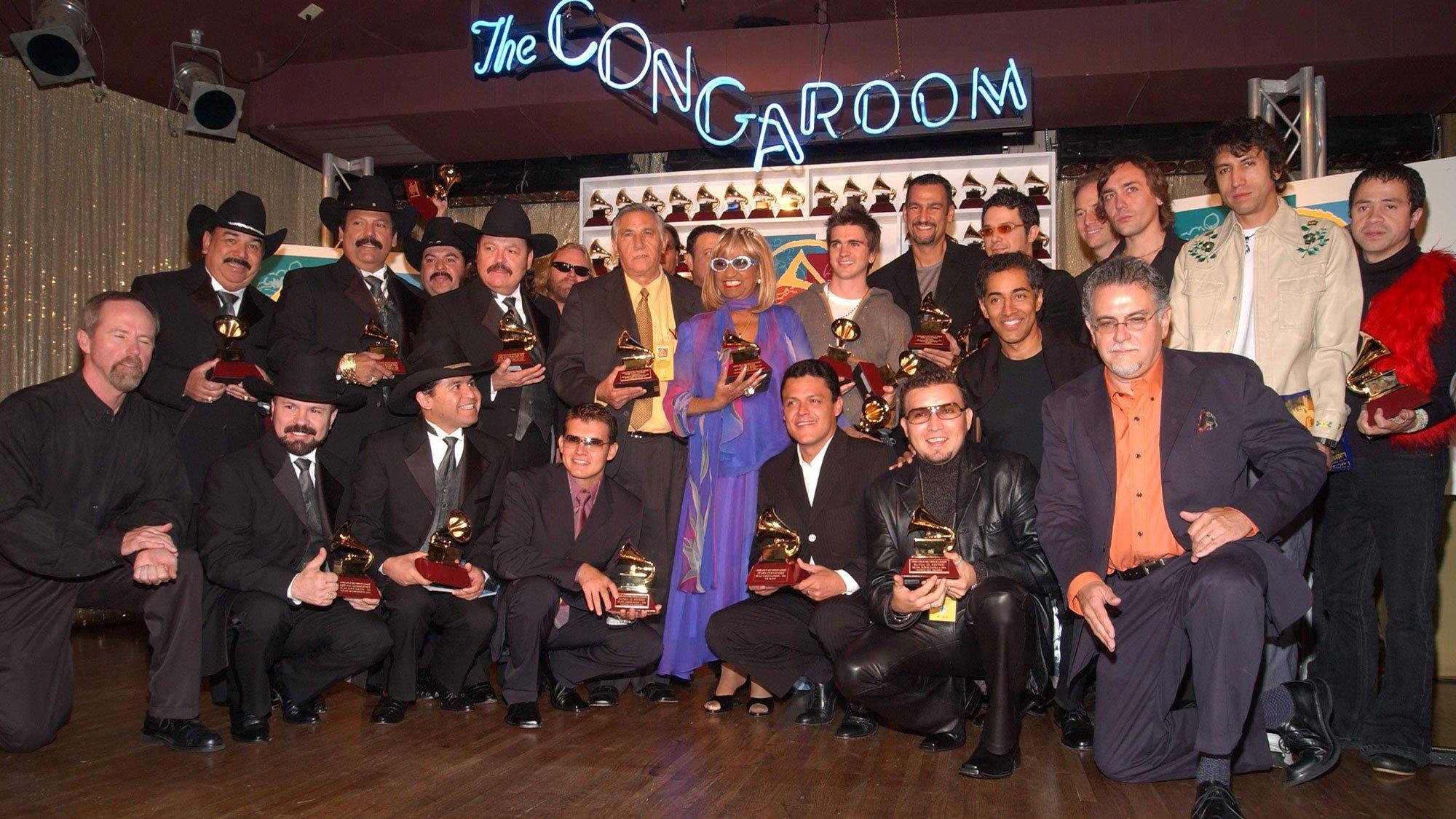Photo: Rich Fury/Getty Images

Juanes & Metallica's Lars Ulrich
news
Metallica's Lars Ulrich Surprises Juanes With Person Of The Year Award At 2019 Latin GRAMMYs
The Danish metal drummer surprised the Colombian legend with a special presentation:at the 20th Latin GRAMMYS: "Tonight, we've come full circle. I proclaim myself a Juanes fan"
The day afterJuanes was honored as the Latin Recording Academy Person Of The Year, there was another special surprise waiting for him in Las Vegas. After the show aired a Juanes tribute reel and the Colombian singer/songwriter delivered showstopping performance, Metallica drummer Lars Ulrich walked out on stage in a red suit and black cap to present his fellow musician with the honor.
<blockquote class="twitter-tweet"><p lang="es" dir="ltr">¡Que emoción! <a href="https://twitter.com/juanes?ref_src=twsrc%5Etfw">@Juanes</a> Persona del Año 2019 <a href="https://twitter.com/hashtag/LatinGRAMMY?src=hash&ref_src=twsrc%5Etfw">#LatinGRAMMY</a> <a href="https://t.co/ErzEAWp9wX">pic.twitter.com/ErzEAWp9wX</a></p>— Latin GRAMMYs (@LatinGRAMMYs) <a href="https://twitter.com/LatinGRAMMYs/status/1195177732734255104?ref_src=twsrc%5Etfw">November 15, 2019</a></blockquote> <script async src="https://platform.twitter.com/widgets.js" charset="utf-8"></script>
Juanes, a well-documented Metallica fan, was visibly moveed by seeing his hero on hand to pay homage.
Ulrich, for his part, was quite honored himself, mentioning that he knew Juanes was a fan of Metallica when they first met years ago in Mexico, but "Tonight, we've come full circle. I proclaim myself a Juanes fan!"
A flattered Juanes accepted the award from Metallica's co-founder, admitting, "You guys changed my life man," as Ulrich exited the stage.
"I used to be a metal man. I still love metal music," Juanes told the Recordiing Academy back in 2014 at Austin City Limits Festival. "I used to have long hair and I am a very big Metallica fan, and Slayer, and Sepultura, and Led Zeppelin and Black Sabbath."
Juanes personal Metallica moment at the 20th Latin GRAMMYs closed out a memorable week for the singer, as his fellow artists came out en masse the previous evening to perform at the Person Of The Year celebration, including Cami, Alessia Cara, Paula Fernandes, Fonseca, Juan Luis Guerra, Mon Laferte, Morat, Ozuna, Draco Rosa, Rosalía, Alejandro Sanz, and Sebastián Yatra. Other guests included Jesse & Joy, Fito Páez, Pablo López and guitarist Orianthil.
Juanes Honored At The 20th Latin GRAMMY Awards' Person Of The Year Ceremony

Photo: Arenovski
feature
Peso Pluma's Road To 'ÉXODO': The GRAMMY Winner Navigates The Consequences Of Global Stardom On New Album
"Fans really get to see the other side of the coin; there are two sides to me. It's darker, rawer," Peso Pluma says of his latest album 'ÉXODO'
Peso Pluma marked his musical destiny with a Tupac tribute tattoo in the center of his clavicle: "All Eyez On Me."
The Mexican artist, born Hassan Emilio Kabande Laija, doesn't remember exactly what year he inked his chest. He knows it was well before his debut in music. Those four words reflected Peso's irrefutable confidence that the world's eyes would eventually be on him.
The world's eyes are indeed on Peso Pluma. In less than two years, the singer achieved global fame by singing corridos tumbados, traversing a path never before trodden by a música Mexicana artist.
At 25, Peso Pluma is at the forefront of a new generation of música Mexicana artists that have successfully modernized traditional Mexican rhythms, such as corridos, by infusing them with elements from urban music and a hip-hop aesthetic. The weight of representing an entire genre and a country could be great for some. But pressure doesn't affect Peso Pluma; on the contrary, it motivates him to keep working to exalt his roots.
"We've come a long way, but we still have a long way to go. And that doesn't mean we have to slow down; it doesn't mean everything is over. This is the beginning of everything," Peso Pluma said in a TikTok video before a performance at the Toyota Arena in Ontario, Canada, a little over a year ago.
Out June 20, Peso's extensive new album ÉXODO seeks to cement his global star status further. Over 24 tracks, the singer continues to explore corridos tumbados and digs into his urban side via much-awaited collaborations with reggaeton and hip-hop icons. Among those big names is Peso's teenage idol, the American rapper and producer Quavo, as well as further afield collaborations with Cardi B.
"ÉXODO is a project I've been working on for over a year before we even won the GRAMMY. GÉNESIS was an incredibly special project, and I knew we couldn't make the same diamond twice," the singer tells GRAMMY.com in a written interview.
Peso Pluma's path to the global stage has been lightning-fast. While he started releasing songs in 2020, Peso will remember March 2023 as the month that propelled him into global mega-stardom. His collaboration with Eslabón Armado on "Ella Baila Sola" led him to become a household name outside his native Mexico.
The hit resonated with an audience eager for new sounds, accompanying social media videos and surpassing a billion streams on Spotify. "Ella Baila Sola" became the first Mexican music track to top the platform's global chart. On Billboard, it conquered No. 1 on the magazine's Global 200 chart for six weeks and reached the coveted No. 4 spot on the Hot 100 chart. The mega-hit took Peso Pluma and Eslabon Armado to make their Latin GRAMMY stage debut in November with an electrifying performance.
Another collaboration, "La Bebe (Remix)" with Mexican reggaeton artist Yng Lvcas, released a day after "Ella Baila Sola," also contributed to Peso Pluma's virality in a completely different genre, but one in which he feels comfortable: urban music.
Learn more: Peso Pluma's 10 Biggest Collabs: From "Bzrp Sessions" To "Ella Baila Sola" &"Igual Que Un Ángel"
As Peso Pluma gained traction with a global audience, his February 2022 single with Raúl Vega, put him, for better or worse, on the map in Mexico. The warlike content of "El Belicón" lyrics and video clip attracted attention for the way it allegedly promoted narcoculture.
Despite growing criticism, Peso Pluma remained tight-lipped regarding references to high-profile members of the Mexican drug trade, as well as drug use and trafficking. In a rare admission to GQ magazine, the singer explained this is a "delicate subject to talk about, but you have to touch on it with transparency — because it's the reality of things."
"In hip-hop, in rap, just like in corridos, and other urban music like reggaeton, it talks about reality. We're not promoting delinquency at all. We're only talking about things that happen in real life," the singer explained.
With the success of "El Belicón" and "Ella Baila Sola" under his belt, Peso Pluma released GÉNESIS in June 2023. Despite being his third album, Peso considers it his true debut in music.
"I didn't want to delete my previous albums [Efectos Secundario and Ah Y Que?] because they represent my beginnings," Peso told Billboard in a cover story published a few weeks after the release of GÉNESIS. In the same conversation, the singer said he saw himself winning his first GRAMMY and breaking more records.
Read more: 5 Takeaways From Peso Pluma's New Album 'GÉNESIS'
In February 2024, Peso Pluma did just that. He took home the golden gramophone for Best Música Mexicana Album (Including Tejano) — his first GRAMMY Award. This victory didn't weigh on him as he approached his next production. "It pushed me to want to create something different that the fans haven't heard from me before," Peso Pluma tells GRAMMY.com.
While GÉNESIS and ÉXODO may differ in substance, they share similarities beyond music. That both records pull from the Bible for their names is not a random occurrence; the opening book of the Hebrew and Christian Bible delves into the genesis of creation, while the Book of Exodus explores the themes of liberation, redemption, and Moses' role in leading the Israelites through the uncharted waters of the Red Sea.
"ÉXODO is the continuation of GÉNESIS, which was the beginning," Peso Pluma explains to GRAMMY.com. "ÉXODO means new beginnings, a new era for me. We are preparing for the next chapter, and that's what we are doing for Mexican music, paving the way, laying the groundwork for what's next because it doesn't stop here."
His "sophomore" album is divided into two discs: the first is corridos, and the second is urban. It also continues the line of collaborations, with twenty tracks where Peso Pluma shares the limelight.
"Some of my fans were craving música Mexicana, and some were craving urbano, and I wanted to give them everything while still staying true to myself and choosing songs and lyrics that spoke to me," he continues.
ÉXODO's disc one starts with "LA DURANGO," the album's fourth single, featuring Eslabon Armando and Junior H. In the record, he also invites collaborators such as Natanael Cano and Gabito Ballesteros for "VINO TINTO" and Mexican rising star Ivan Cornejo on the melancholic "RELOJ," among others.
For Side B, Peso enlisted heavyweights from the urban genre in the Anglo and Latin markets: Anitta in the steamy "BELLAKEO," Rich The Kid in the bilingual "GIMME A SECOND," and Quavo in the existential trap "PA NO PENSAR." Cardi B, Arcángel, Ryan Castro, Kenia OS, and DJ Snake complete ÉXODO's genre crossover.
In ÉXODO, luxury, drugs, alcohol, and women continue to take center stage in the lyrics, accompanied by fast-paced guitar-driven melodies and reverb-dense vocals. However, the production sheds light on the vulnerable side of Peso and explores the unexpected consequences of becoming globally famous.
"Fans really get to see the other side of the coin; there are two sides to me. It's darker, rawer," Peso says about the record.
In the songs "HOLLYWOOD" and "LA PATRULLA," for example, Peso details how this musical path keeps him up at night, as well as his aspirations, and how he remains the same despite his success.
Perhaps one of the deepest and rawest songs on the album is "14:14," a track inspired by the Bible verse 14:14 from the Book of Exodus, which, the singer explains, was fundamental amidst the turbulence he faced on the way to global stardom.
"[The] verse 14:14 says 'The LORD will fight for you; you need only to be still.' This verse couldn't be truer," Peso Pluma says. "Over time, I learned to really trust in this and believe that some things are not up to me and I should trust the process."
In the song — one of the few on the album without a collaboration — Peso references the challenges of his profession and how his faith has kept him afloat amid the vicissitudes. "Things from the job that no one understands/I hide the rosary under my shirt so I don't poison myself, so I don't feel guilty/because whatever happens, the Boss will forgive me," he sings.
In "BRUCE WAYNE," Peso Pluma croons about the passionate feelings his career arouses: "First they love you, and then they hate you/wishing the worst, envy and death," the song says.
The singer resorts to comparing himself to a superhero figure again. In an unusual twist, Peso crosses comic universes, moving from his now traditional reference to Spider-Man to one from the DC Comics world: Bruce Wayne, Batman's secret identity. A wealthy man, part of Gotham's high society, Bruce Wayne is known for transforming his darkness into power while remaining reserved and isolated.
"Everyone has two sides of them, even me," Peso tells GRAMMY.com. "Peso Pluma on stage is a high-energy person, someone who is powerful and dominates a show and isn't afraid of anything. And then there is Hassan, who's chill and more relaxed and who deals with all the realities of life."
During the year and a half it took him to complete ÉXODO, Peso Pluma had to deal with the diverse nuances of a global star's life, including a widely publicized breakup from Argentine rapper/singer Nicki Nicole, the cancellation of one of his shows in October 2023 after a Mexico drug cartel issued a death threat against him, and a media frenzy over his alleged admission to a rehabilitation clinic, the latest a rumor he laid to rest during a March interview with Rolling Stone for his Future of Music cover story.
"The reality is, all these days, I've been in the studio working on ÉXODO," the artist explained to Rolling Stone.
Most of 2023 was a successful balancing act for Peso Pluma, who combined touring, an album release, rare media engagements, two Coachella appearances, all the while developing another record. According to the singer, ÉXODO was created in Los Angeles, Miami, New York, and Mexico. "We go to the studio everywhere!" Peso says. "It doesn't really matter where we are; I love to get into the studio and work when we have free time."
Like GÉNESIS, ÉXODO will be released via Peso Pluma's Double P Records, of which he is the CEO and A&R. Much of the talent the Mexican singer has signed to his label took part in the album's production, and songwriting process.
"For the Mexican music side, I had the whole [touring] band with me; I like to have them involved in the process so that we can all give our input on how it sounds, discuss what we think needs to be changed, create new ideas," he explains.
Peso Pluma knows that echoing the success of 2023 is no easy task. He was the most streamed artist in the U.S. on YouTube, surpassing Taylor Swift and Bad Bunny, and was the second most-listened to Latin artist in the country, amassing an impressive 1.9 billion streams, according to Luminate.
Música Mexicana emerged as one of the most successful genres in 2023, witnessing a remarkable 60 percent surge in streaming numbers, adds Luminate's annual report, crediting Peso Pluma along Eslabon Armado, Junior H, and Fuerza Regida as part of this success.
Collaborations on and off the mic have undoubtedly played a significant role in the rise of Música Mexicana on the global stage. Peso knows that the key to continuing onward is teaming up with renowned artists inside and outside his genre.
"All of us coming together is what pushed música Mexicana to go global," the singer affirms. "We showed the world what Mexico has to offer, and now no one can deny the power and talent we have in our country."

Photo: Jathan Campbell
list
How Much Is A GRAMMY Worth? 7 Facts To Know About The GRAMMY Award Trophy
Here are seven facts to know about the actual cost and worth of a GRAMMY trophy, presented once a year by the Recording Academy at the GRAMMY Awards.
Since 1959, the GRAMMY Award has been music’s most coveted honor. Each year at the annual GRAMMY Awards, GRAMMY-winning and -nominated artists are recognized for their musical excellence by their peers. Their lives are forever changed — so are their career trajectories. And when you have questions about the GRAMMYs, we have answers.
Here are seven facts to know about the value of the GRAMMY trophy.
How Much Does A GRAMMY Trophy Cost To Make?
The cost to produce a GRAMMY Award trophy, including labor and materials, is nearly $800. Bob Graves, who cast the original GRAMMY mold inside his garage in 1958, passed on his legacy to John Billings, his neighbor, in 1983. Billings, also known as "The GRAMMY Man," designed the current model in use, which debuted in 1991.
How Long Does It Take To Make A GRAMMY Trophy?
Billings and his crew work on making GRAMMY trophies throughout the year. Each GRAMMY is handmade, and each GRAMMY Award trophy takes 15 hours to produce.
Where Are The GRAMMY Trophies Made?
While Los Angeles is the headquarters of the Recording Academy and the GRAMMYs, and regularly the home of the annual GRAMMY Awards, GRAMMY trophies are produced at Billings Artworks in Ridgway, Colorado, about 800 miles away from L.A.
Is The GRAMMY Award Made Of Real Gold?
GRAMMY Awards are made of a trademarked alloy called "Grammium" — a secret zinc alloy — and are plated with 24-karat gold.
How Many GRAMMY Trophies Are Made Per Year?
Approximately 600-800 GRAMMY Award trophies are produced per year. This includes both GRAMMY Awards and Latin GRAMMY Awards for the two Academies; the number of GRAMMYs manufactured each year always depends on the number of winners and Categories we award across both award shows.
Fun fact: The two GRAMMY trophies have different-colored bases. The GRAMMY Award has a black base, while the Latin GRAMMY Award has a burgundy base.
Photos: Gabriel Bouys/AFP via Getty Images; Frederick M. Brown/Getty Images
How Much Does A GRAMMY Weigh?
The GRAMMY trophy weighs approximately 5 pounds. The trophy's height is 9-and-a-half inches. The trophy's width is nearly 6 inches by 6 inches.
What Is The True Value Of A GRAMMY?
Winning a GRAMMY, and even just being nominated for a GRAMMY, has an immeasurable positive impact on the nominated and winning artists. It opens up new career avenues, builds global awareness of artists, and ultimately solidifies a creator’s place in history. Since the GRAMMY Award is the only peer-voted award in music, this means artists are recognized, awarded and celebrated by those in their fields and industries, ultimately making the value of a GRAMMY truly priceless and immeasurable.
In an interview featured in the 2024 GRAMMYs program book, two-time GRAMMY winner Lauren Daigle spoke of the value and impact of a GRAMMY Award. "Time has passed since I got my [first] GRAMMYs, but the rooms that I am now able to sit in, with some of the most incredible writers, producers and performers on the planet, is truly the greatest gift of all."
"Once you have that credential, it's a different certification. It definitely holds weight," two-time GRAMMY winner Tariq "Black Thought" Trotter of the Roots added. "It's a huge stamp as far as branding, businesswise, achievement-wise and in every regard. What the GRAMMY means to people, fans and artists is ever-evolving."
As Billboard explains, artists will often see significant boosts in album sales and streaming numbers after winning a GRAMMY or performing on the GRAMMY stage. This is known as the "GRAMMY Effect," an industry phenomenon in which a GRAMMY accolade directly influences the music biz and the wider popular culture.
For new artists in particular, the "GRAMMY Effect" has immensely helped rising creators reach new professional heights. Samara Joy, who won the GRAMMY for Best New Artist at the 2023 GRAMMYs, saw a 989% boost in sales and a 670% increase in on-demand streams for her album Linger Awhile, which won the GRAMMY for Best Jazz Vocal Album that same night. H.E.R., a former Best New Artist nominee, saw a massive 6,771% increase in song sales for her hit “I Can’t Breathe” on the day it won the GRAMMY for Song Of The Year at the 2021 GRAMMYs, compared to the day before, Rolling Stone reports.
Throughout the decades, past Best New Artist winners have continued to dominate the music industry and charts since taking home the GRAMMY gold — and continue to do so to this day. Recently, Best New Artist winners dominated the music industry and charts in 2023: Billie Eilish (2020 winner) sold 2 million equivalent album units, Olivia Rodrigo (2022 winner) sold 2.1 million equivalent album units, and Adele (2009 winner) sold 1.3 million equivalent album units. Elsewhere, past Best New Artist winners have gone on to star in major Hollywood blockbusters (Dua Lipa); headline arena tours and sign major brand deals (Megan Thee Stallion); become LGBTIA+ icons (Sam Smith); and reach multiplatinum status (John Legend).
Most recently, several winners, nominees and performers at the 2024 GRAMMYs saw significant bumps in U.S. streams and sales: Tracy Chapman's classic, GRAMMY-winning single "Fast Car," which she performed alongside Luke Combs, returned to the Billboard Hot 100 chart for the first time since 1988, when the song was originally released, according to Billboard. Fellow icon Joni Mitchell saw her ‘60s classic “Both Sides, Now,” hit the top 10 on the Digital Song Sales chart, Billboard reports.
In addition to financial gains, artists also experience significant professional wins as a result of their GRAMMY accolades. For instance, after she won the GRAMMY for Best Reggae Album for Rapture at the 2020 GRAMMYs, Koffee signed a U.S. record deal; after his first GRAMMYs in 2014, Kendrick Lamar saw a 349% increase in his Instagram following, Billboard reports.
Visit our interactive GRAMMY Awards Journey page to learn more about the GRAMMY Awards and the voting process behind the annual ceremony.

Photo: Courtesy of the Conga Room
news
L.A.’s Historic Conga Room Closes With A Final Party Celebrating Latin Music Excellence
The L.A. Live venue will officially close its doors at the end of March, after two decades of supporting live Latin music (and the Latin GRAMMYs). Ahead of their farewell party, the Conga Room's founder and staff discuss its history and significance.
Los Angeles' legendary Conga Room is closing its doors, but will not go quietly into the night.
The 25-year-old venue has been home to countless Latin music performances and celebrations — including the 2001 Latin GRAMMYs — and will host its final event on March 27. The official, invitation-only closing celebration will feature a performance by Puerto Rican salsa star Gilberto Santa Rosa and the Conga Kids, as well appearances from Jimmy Smits and Paul Rodriguez, both of whom were investors in the space.
First opened in 1999 on Wilshire Boulevard by real estate entrepreneur and Latin music lover Brad Gluckstein, the Conga Room drew investors like Jennifer Lopez and Sheila E — all of whom were committed to the venue’s vision of being an upscale nightclub devoted to live Latin music and dancing. In both its Miracle Mile location and its later space at L.A. Live, the club attracted an absolutely staggering lineup of talent, including Celia Cruz, Buena Vista Social Club, Tito Puente, Carlos Santana, Alejandro Fernández, Fito Paez, Jerry Rivera, Bad Bunny, and Maluma. The venue also hosted performances from non-Latinx artists like Prince, Ed Sheeran, Lenny Kravitz, Kendrick Lamar, Stevie Wonder, Chaka Khan, and Avicii.
"I saw Prince perform in venues the world over, but his very first performance at the Conga Room was magical," says talk show host Tavis Smiley. "Of all the times I witnessed my friend on stage, from Madison Square Garden to Montreux, the Conga Room remains my favorite Prince performance."
Gluckstein says that the Conga Room was able to draw such great talent not just because it was one of the only major venues that leaned into Latin music in the United States, but because there was a mutual respect between the artists and the venue.
"We couldn’t compete financially with [Goldenvoice or AEG], but we were able to bring an incredible amount of talent to the venue," he tells GRAMMY.com. "I was talking to Jerry Rivera’s agent the other day and I said, ‘Jerry just played in front of 10,000 people in Venezuela. Help me understand why playing in front of 1,000 people at the Conga room was so important.’ He went on for 10 minutes about what the room meant to these artists and the way we respected them, the sound system, and the way they were treated. The fan engagement, too, plus the fact that there was never really a comparable room anywhere else, even in New York."
"We provided a stage and a voice for acts that didn’t have a way of getting to their audience here in L.A., because no radio stations were playing their kind of music," says Marcella Cuonzo, the venue’s publicist. "For reggaeton, for example, the Conga Room was a pioneer in the movement around 2010. Radio wasn’t playing that music, but the Conga Room took a gamble on the sound because they saw its vision."
The Conga Room was also the first venue in Los Angeles to host a wide-range of Cuban musical talent starting in the mid- to late ‘90s. "We had probably 50 shows," says Gluckstein. "We got everything from Bebo Valdés to [Diego] El Cigala to Pablo Milanés, who played his first show ever in the U.S. at our venue. He’s the Bob Dylan of Cuba. We brought Los Van Van, who’s probably the most famous salsa or timba group in the history of Cuba. They couldn’t play in Miami, because Miami wouldn’t allow Cuban music, so the GRAMMYs gave them their trophy [for Best Salsa Performance] at the Conga Room."
The Latin GRAMMY Awards moved from L.A. from Miami in 2001, and the ceremony was set to take place at the Shrine Auditorium on Sept. 11. That telecast was understandably canceled following the tragic events of that day in New York, and rather than rescheduling the whole event, winners were announced at a press conference on Oct. 30 at the Conga Room. Alejandro Sanz came away with four awards, including Album Of The Year, and Juanes took home three Latin GRAMMYs, including Best New Artist.
"I remember Celia Cruz giving a beautiful speech that night in Spanish, thanking the firefighters and policemen and saying ‘this is for you, but also a little bit for us," says Gluckstein. "In later years, once we were at L.A. Live, we hosted the Latin GRAMMY nominations several times. I have footage of Andy Garcia doing them on-stage with Jimmy Smits."
The Conga Room is closing now because, Gluckstein says, it just seems like the right time. "The pandemic, of course, played a role," he explains. "And I think the enormity of AEG and Live Nation, with how fierce the competition is, all of that has made buying talent much more expensive and has made talent more selective in terms of what's the best economic opportunity for them."
There’s also the rising success of Conga Kids, the venue’s non-profit arm, to consider. A county-wide organization with about 100 employees, Conga Kids reaches roughly 50,000 elementary-aged kids in largely under-resourced communities every year, using dance and music from the Afro-Diaspora like salsa, merengue, cumbia, reggaeton, Charleston, and hip-hop to promote social and emotional well-being, as well as diversity, equity, and inclusivity.
Though fans and artists will undoubtedly miss the space, energy, and community the Conga Room provided, Gluckstein says the venue’s closure doesn’t have to be sad. Instead, he says, it can be celebratory.
"We accomplished so much," he says. "Now, the venue will just have to live on in the hearts and minds of people, instead of as a brick and mortar space."

Photo: Lester Cohen/Getty Images for The Recording Academy
news
How The Latin GRAMMYs Brought Latin Music Excellence To The 2024 GRAMMYs
Latin music was celebrated throughout GRAMMY Week and on Music's Biggest Night. Read on for the many ways Latin music excellence was showcased at the 204 GRAMMYs.
The 2023 Latin GRAMMYs may have occurred months ago and thousands of miles away, but the leading lights in Latin music also shined at the 66th GRAMMY Awards. From historic wins and meaningful nominations, to electric performances and interesting installations, Latin music excellence was everywhere.
In anticipation of the 25th anniversary of the Latin GRAMMYs in 2024, the exclusive GRAMMY House — the site of multiple GRAMMY Week events — included a significant installation dedicated to the Biggest Night In Latin Music.
The cylindrical display showcased some of the biggest moments in Latin GRAMMY history, including images, facts, and even a real Latin GRAMMY award.
The celebration of Latin music continued throughout GRAMMY Week, with several Latin GRAMMY-winning artists also winning on the GRAMMY stage. Among the major moments at the 2024 GRAMMYs, Karol G won her first golden gramophone for her 2023 LP Mañana Será Bonito. "This is my first time at GRAMMYs, and this is my first time holding my own GRAMMY," the Colombian songstress exclaimed during her acceptance speech.
Música Mexicana star Peso Pluma also took home his first GRAMMY; his album GÉNESIS won in the Best Música Mexicana Album (Including Tejano) Category.
Premiere Ceremony presenter Natalia Lafourcade — whose Todas Las Flores won big at the 2023 Latin GRAMMYs — also took home the GRAMMY Award for Best Latin Rock or Alternative Album. She tied in the Category with Juanes.
Premiere Ceremony performer Gabby Moreno also took home a GRAMMY Award for Best Latin Pop Album for her album X Mí (Vol. 1).
Beyond the stage, Latin artists graced the red carpet and the nominations list. For example, producer and songwriter Edgar Barrera was the only Latino nominated in the Songwriter Of The Year, Non-Classical Category.
